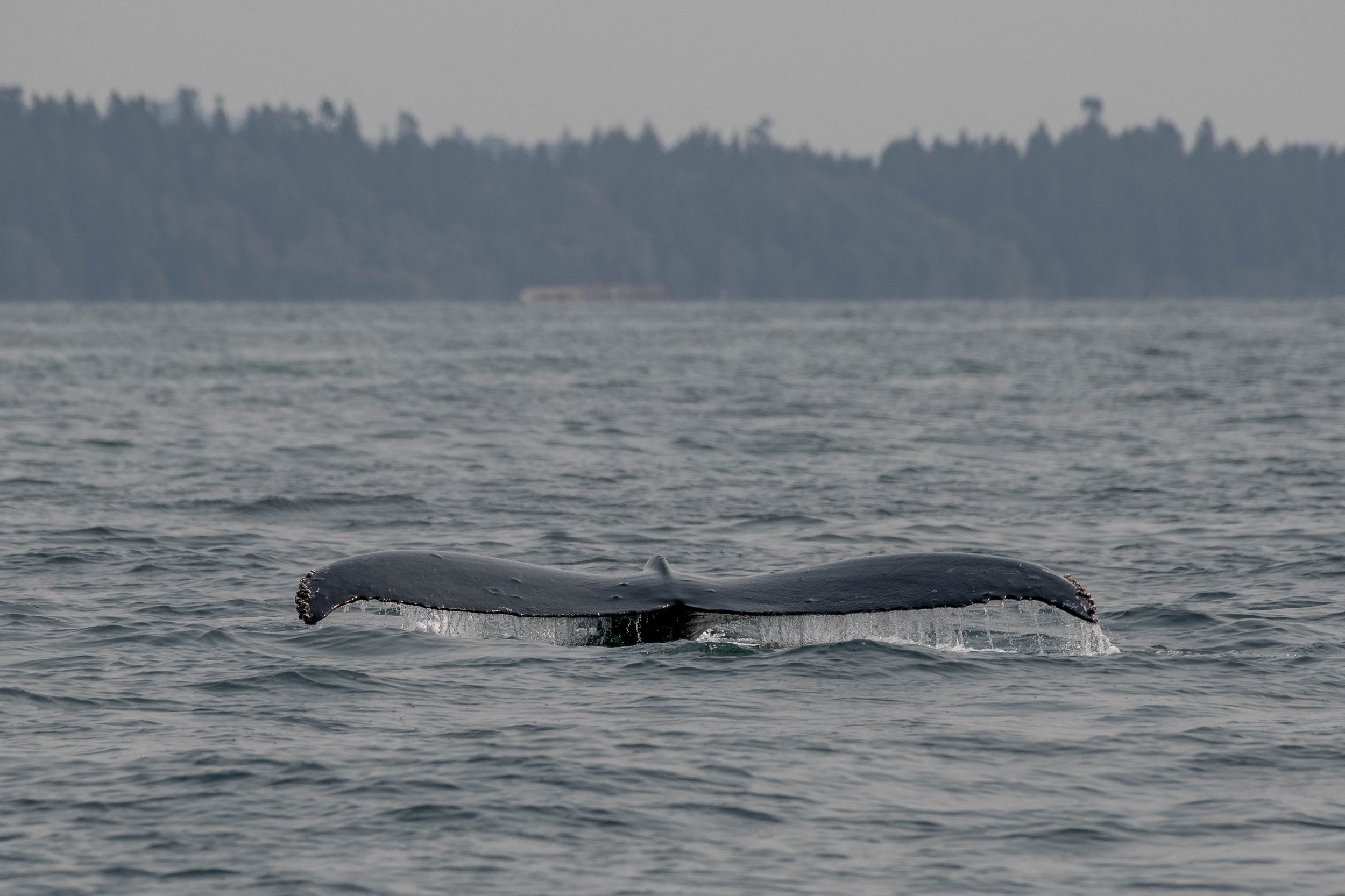September 8, 2024, 10:30 am - The T100s get 'schooled' (travelling by UBC)!
All of the whales in our area are free of trackers and tags - this means sometimes we have to do some searching before we find them and it also means we don’t know where we will be ahead of time. Sometimes they are close to our home port, sometimes we have to go on an adventure. Today was the latter - we crossed the Strait of Georgia to find the T100s who were busy travelling near UBC in Vancouver:
T100 Hutchins ♀ (1979)
T100C Laurel ♂ (2002)
T100E Tharaya ♀ (2009)
T100F Estrella ♀ (2014)
We are happy Tharaya has joined back up with her pod. For some reason Tharaya took an extended vacation from her family - she left her mother and siblings’ sides early last year and until recently had been pod hopping and was most commonly seen during T-parties (gatherings of multiple Transient orca pods together). Did she get in a fight with her mother? Did she decide she wanted to do some adventuring of her own? It’s hard to tell! Quite a few of her sightings were with T100B Freya, her eldest sister. She might be learning the ropes of surviving independently from her older sister to disperse herself once she has her first calf. At 15 years old, Tharaya could start reproducing at any time - she might even be pregnant right now and sticking by her mother’s side again so she has help when she gives birth! Whatever the case, we were excited to see her back with her natal pod and we hope we can see them all travelling together more in the future too!
After watching the T100s travel we departed them and went back into search mode. While we usually find seals, sea lions, and birds at this point, today we got extra lucky and found more whales! This time it was humpbacks - specifically a mother and calf travelling along. These whales were identified as Anvil (BCZ0410) and her 2024 calf (BCZ0410 calf 2024), also known as “Rubber Ducky”. The duo was busy foraging away when we were observing them. Anvil and Rubber Ducky will only be travelling together for a few more months before they say farewell and part ways. Calves stay with their mothers generally for a year. In that time, they are learning how to get to and from the breeding grounds as well as where the best places are to forage and get chunky in preparation for their migration.
While it will be sad once these two split, we are hoping to see both of them back in our area in future years. Humpbacks tend to display site fidelity, meaning Rubber Ducky will likely return to this part of the Salish Sea in the future. Safe travels, little one!
Once we departed Anvil and her calf we started to cross back towards our home port. We were aiming for Gabriola Island when suddenly we found more orca! This time it was a pair of larger male dorsal fins, ID’d as the T060 brothers:
T60D Onca ♂ (2004)
T60E Lynx ♂ (2008)
These two are a rare sighting for our company. Our first sighting of them was back in September 2021. These brothers have been (for the most part) travelling away from their matriline since 2019. They tend to meet back up with her and their siblings briefly every couple of months, and then they take off on their own again. This is quite unusual for our orca as males tend to be very reliant on their mothers their entire lives. These two seem to be ‘odd ducks’ though, as they appear to be doing just fine off on their own!
After stopping with the brothers for a bit we had to head on out and began the trek back to dock. Once we have docked the wildlife sightings are usually over, however that wasn’t the case today! We saw a Great Blue Heron eyeing the waters up right beside our boats as we made our way back up to the office - likely looking for dinner.
Please enjoy this trip’s photos taken by Marine Naturalist Aly Kohlman!
T100C Laurel swims past.
T100C Laurel checks out a prawn trap
Can you see his eyepatch?
Matriarch T100 Hutchins was born in 1979!
T100 Hutchins makes waves.
Middle child T100E Tharaya makes an appearance.
Check out the scarring on T100E Tharaya's saddlepatch.
T100E Tharaya glides on by.
T100E Tharaya is a lot pointier than her siblings!
Anvil goes on a dive, with her calf close by.
Waterfall!
Anvil shows off her distinctive fluke.
A beautiful fluke in front of Vancouver.
T069D Onca sports a new scar.
The two brothers, T060D Onca and T060E Lynx.
T060E Lynx shows off a bit of his eyepatch.
Both brothers have very distinct dorsals!
T060E Lynx has two notches out of his dorsal- perfect for IDing!
T060E Lynx comes up for a breath.
T060E Lynx cruises along.
Now we get to see T060E Lynx's eyepatch!
A stunning Blue Heron eyes up lunch.
What a beauty!























